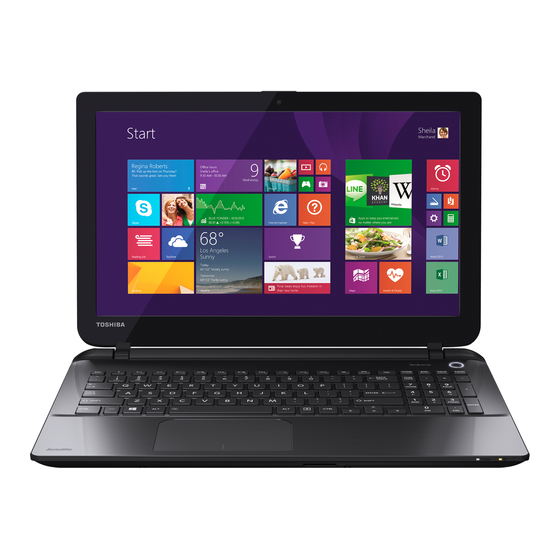Summarization of Contents
TOSHIBA Legal, Regulatory and Safety
Copyright, Disclaimer and Trademarks
Covers copyright, disclaimer, and trademark policies for the manual and TOSHIBA.
Regulatory Information
Details FCC and CE compliance, contact information, and regulatory statements.
General Precautions
General precautions for safe computer operation and to prevent injury.
Safety Icons
Explains the meaning of various safety icons used in the manual.
ENERGY STAR Program
Explains ENERGY STAR compliance and energy-saving features.
Optical disc drive safety instructions
Safety precautions for optical disc drives.
Getting Started
Equipment checklist
Lists essential hardware and documentation included with the computer.
Using your computer for the first time
Provides basic steps and precautions for initial computer use.
Connecting the AC adaptor
Detailed instructions on connecting the AC adaptor for power and charging.
Turning on the power
Steps to turn on the computer and initial setup guidance.
Turning off the power
Describes modes for turning off the computer (Shut Down, Sleep, Hibernation).
Sleep Mode
Explains Sleep Mode for interrupting work and power saving.
Hibernation Mode
Explains Hibernation Mode for saving state and power.
The Grand Tour
Front with the display closed
Identifies components on the front of the computer when the display is closed.
Left side
Identifies ports and vents on the left side of the computer.
Right side
Identifies ports and features on the right side of the computer.
Front with the display open
Identifies components on the front with the display open.
Internal Hardware Components
Details internal hardware components of the computer.
Power Condition Descriptions
Explains power status indicators and conditions.
Operating Basics
Using the Touch Screen
Explains how to use the touch screen and its gestures.
The Keyboard
Describes keyboard layout, keys, and indicators.
Optical disc drives
Information on optical disc drives and their indicators.
Battery
Explains battery types, use, recharging, and handling.
External Display
How to connect and use external displays with the computer.
Sound System and Video mode
Describes audio control functions and video modes.
Utilities and Advanced Usage
Utilities and Applications
Overview of pre-installed utilities and how to start them.
TOSHIBA eco Utility
Utility for managing power consumption and savings.
TOSHIBA Password utility
Provides two levels of password security: User and Supervisor.
TOSHIBA HWSetup
Configuration management tool for hardware settings.
TOSHIBA PC Health Monitor
Monitors system functions like power, battery, and cooling.
System Recovery
Options for system recovery and media creation.
Troubleshooting
Problem solving process
Guidelines for identifying and resolving computer problems.
Preliminary checklist
Basic checks to perform before deeper troubleshooting.
Analyzing the problem
Questions to ask when analyzing computer malfunctions.
Hardware and system checklist
Checklist for hardware and peripheral issues.
Power
Troubleshooting power-related issues.
Battery
Troubleshooting battery-related problems.
TOSHIBA support
How to contact TOSHIBA support for assistance.
Appendix
Specifications
Summarizes the computer's technical specifications.
Environmental Requirements
Specifies operating and non-operating environmental conditions.
Power Requirements
Lists AC adaptor and computer power requirements.
Information for Wireless Devices
Details wireless technology interoperability and standards.
Glossary
Definitions of terms and abbreviations used in the manual.













Need help?
Do you have a question about the Satellite Pro L50D-B and is the answer not in the manual?
Questions and answers